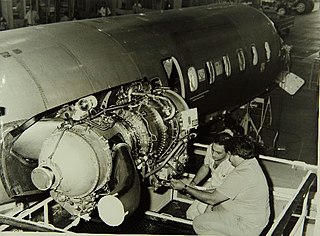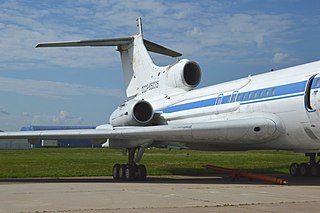
A turboprop engine is a turbine engine that drives an aircraft propeller.

The Tupolev Tu-85 was a Soviet prototype strategic bomber based on the Tu-4, an unlicensed reverse engineered copy of the Boeing B-29 Superfortress. It was the ultimate development of the B-29 family, being over 50% heavier than its progenitor and had nearly double the range. Only two prototypes were built before the program was cancelled in favor of the turboprop powered Tupolev Tu-95 bomber which was much faster and had the same range.
The Kuznetsov Design Bureau was a Russian design bureau for aircraft engines, administrated in Soviet times by Nikolai Dmitriyevich Kuznetsov. It was also known as (G)NPO Trud and Kuybyshev Engine Design Bureau (KKBM).

The Kuznetsov NK-12 is a Soviet turboprop engine of the 1950s, designed by the Kuznetsov design bureau. The NK-12 drives two large four-bladed contra-rotating propellers, 5.6 m (18 ft) diameter (NK-12MA), and 6.2 m (20 ft) diameter (NK-12MV). It is the most powerful turboprop engine to enter service.

The Tupolev Tu-95LAL,, was an experimental aircraft that was a modified Tupolev Tu-95 Soviet bomber aircraft, which flew from 1961 to 1965, analogous to the United States' earlier Convair NB-36H. It was intended to see whether a nuclear reactor could be used to power an aircraft, primarily testing airborne operation of a reactor and shielding for components and crew.

The Kuznetsov NK-86 is a low bypass turbofan engine used on the Ilyushin Il-86 rated at 13,000 kgf or 28,600 lbf thrust. It is made by the Soviet Kuznetsov Design Bureau. It is an upgraded version of the Kuznetsov NK-8.
JSC Kuznetsov is one of the leading Russian producers of aircraft engines, liquid-propellant rocket engines as well as aeroderivative gas turbines and modular stations.
The Kuznetsov NK-87 is a low-bypass turbofan engine rated at 127.5 kN thrust. It powers the Lun-class ekranoplan. It is made by the soviet Kuznetsov Design Bureau.
Nikolai Dmitriyevich Kuznetsov was a Chief Designer of the Soviet Design Bureau OKB-276 which deals with the development, manufacture and distribution of equipment, especially aircraft engines, turbines and gearboxes.

The General Electric T31 was the first turboprop engine designed and built in the United States.

The Kuznetsov NK-25 is a turbofan aircraft engine used in the Tupolev Tu-22M strategic bomber. It can equal the NK-321 engine as one of the most powerful supersonic engines in service today. It is rated at 245 kN (55,000 lbf) thrust. The three shaft engine we call the NK-25 was designed in the years 1972–1974. It is made by the Soviet Kuznetsov Design Bureau.

The Garrett TPF351 is a turboprop engine designed by Garrett Engine Division of AlliedSignal Aerospace Company. Initiated by Garrett in October 1987, the TPF351-20 engine was selected by Embraer to power the Embraer/FMA CBA 123 Vector, a high-speed commuter "pusher" aircraft. It was first tested on May 19, 1989 and then ground tested and flight tested on a Boeing 720 on July 9, 1990. The first prototype CBA 123 was tested on July 18, 1990, followed by a flight to the Farnborough Air Show in September of the same year. Both programs were cancelled in 1992, when the TPF351 was nine months from engine certification.

The Ivchenko AI-20 is a Soviet turboprop engine developed by the Ivchenko design bureau in the 1950s. It has been built in large numbers, serving as the powerplant for the Antonov An-12 transport and the Ilyushin Il-18 airliner.

The Kuznetsov NK-93 was a civilian aircraft engine, a hybrid between a turbofan and a turboprop known as a propfan. The engine was also unique in having a separate duct around the contra-rotating propellers, as most other propfans are unducted. Once described in a respected aviation encyclopedia as "potentially the most fuel-efficient aircraft jet engine ever to be tested," the NK-93 was targeted for derivatives of Soviet/Russian airliners such as the Ilyushin Il-96, Tupolev Tu-204, and Tupolev Tu-330. Five in-flight engine tests were conducted on the NK-93 from December 2006 to December 2008.
The Kuznetsov NK-4 was a Soviet turboprop engine, designed by the Kuznetsov Design Bureau.
The Kuznetsov NK-22 is an afterburning turbofan engine, designed by the Kuznetsov Design Bureau.

The Kuznetsov NK-88 was an experimental alternative fuel turbofan engine, designed by the Kuznetsov Design Bureau.
The Kuznetsov NK-89 was an experimental alternative fuel turbofan engine, designed by the Kuznetsov Design Bureau.
The Kuznetsov NK-6 was a low-bypass afterburning turbofan engine, designed by the Kuznetsov Design Bureau.
The Kuznetsov TV-2 was an early Soviet turboprop engine, designed by the Kuybyshev Engine Design Bureau.











